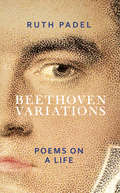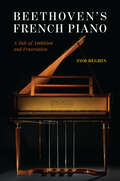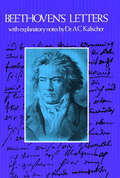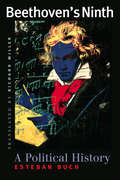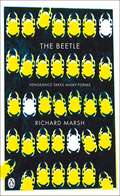- Table View
- List View
The Beethoven Medal: Book 2 (Pennington #2)
by K M PeytonBeing in love with Patrick Pennington isn't easy. With his all-consuming passion for music, and his desperate need for freedom, Ruth isn't sure there's room for her in his life. Will he ever love and need her in return?
The Beethoven Syndrome: Hearing Music as Autobiography
by Mark Evan BondsThe "Beethoven Syndrome" is the inclination of listeners to hear music as the projection of a composer's inner self. This was a radically new way of listening that emerged only after Beethoven's death. Beethoven's music was a catalyst for this change, but only in retrospect, for it was not until after his death that listeners began to hear composers in general--and not just Beethoven--in their works, particularly in their instrumental music. The Beethoven Syndrome: Hearing Music as Autobiography traces the rise, fall, and persistence of this mode of listening from the middle of the eighteenth century to the present. Prior to 1830, composers and audiences alike operated within a framework of rhetoric in which the burden of intelligibility lay squarely on the composer, whose task it was to move listeners in a calculated way. But through a confluence of musical, philosophical, social, and economic changes, the paradigm of expressive objectivity gave way to one of subjectivity in the years around 1830. The framework of rhetoric thus yielded to a framework of hermeneutics: concert-goers no longer perceived composers as orators but as oracles to be deciphered. In the wake of World War I, however, the aesthetics of "New Objectivity" marked a return not only to certain stylistic features of eighteenth-century music but to the earlier concept of expression itself. Objectivity would go on to become the cornerstone of the high modernist aesthetic that dominated the century's middle decades. Masterfully citing a broad array of source material from composers, critics, theorists, and philosophers, Mark Evan Bonds's engaging study reveals how perceptions of subjective expression have endured, leading to the present era of mixed and often conflicting paradigms of listening.
The Beethoven Syndrome: Hearing Music as Autobiography
by Mark Evan BondsThe "Beethoven Syndrome" is the inclination of listeners to hear music as the projection of a composer's inner self. This was a radically new way of listening that emerged only after Beethoven's death. Beethoven's music was a catalyst for this change, but only in retrospect, for it was not until after his death that listeners began to hear composers in general--and not just Beethoven--in their works, particularly in their instrumental music. The Beethoven Syndrome: Hearing Music as Autobiography traces the rise, fall, and persistence of this mode of listening from the middle of the eighteenth century to the present. Prior to 1830, composers and audiences alike operated within a framework of rhetoric in which the burden of intelligibility lay squarely on the composer, whose task it was to move listeners in a calculated way. But through a confluence of musical, philosophical, social, and economic changes, the paradigm of expressive objectivity gave way to one of subjectivity in the years around 1830. The framework of rhetoric thus yielded to a framework of hermeneutics: concert-goers no longer perceived composers as orators but as oracles to be deciphered. In the wake of World War I, however, the aesthetics of "New Objectivity" marked a return not only to certain stylistic features of eighteenth-century music but to the earlier concept of expression itself. Objectivity would go on to become the cornerstone of the high modernist aesthetic that dominated the century's middle decades. Masterfully citing a broad array of source material from composers, critics, theorists, and philosophers, Mark Evan Bonds's engaging study reveals how perceptions of subjective expression have endured, leading to the present era of mixed and often conflicting paradigms of listening.
Beethoven Variations: Poems on a Life
by Ruth PadelFrom the author of the bestselling Darwin: A Life in Poems, Ruth Padel’s new collection follows in the footsteps of one of the world’s greatest composers, Beethoven, and investigates what his life and music might mean to us todayTwo hundred and fifty years since Beethoven was born, Ruth Padel goes on a personal search for him, retracing his steps through war-torn Europe of the early nineteenth century, delving into his music, letters, diaries and the conversation books he used when deaf, to uncover the man behind the legend. Her quest, exploring the life of one of the most creative artists who ever lived, turns more personal than she expects, taking her into the sources of her own creativity and musicality. From a deeply musical family herself, Padel’s parents met through music, and she grew up playing chamber music on viola – Beethoven’s instrument as a child. Her father’s grandfather, a concert pianist born on the German–Danish border, studied in Leipzig with a friend of Beethoven before immigrating to the UK. The poems in this illuminating biography in verse conjure not only Beethoven’s life and personality, but her own music-making and love both of the European music-making tradition to which her father’s family belongs, and to the continent itself Europe.
Beethoven: Variations on a Life
by Mark Evan BondsDespite the ups and downs of his personal life and professional career-even in the face of deafness-Beethoven remained remarkably consistent in his most basic convictions about his art. This inner consistency, the music historian Mark Evan Bonds argues, provides the key to understanding the composer's life and works. Beethoven approached music as he approached life, weighing whatever occupied him from a variety of perspectives: a melodic idea, a musical genre, a word or phrase, a friend, a lover, a patron, money, politics, religion. His ability to unlock so many possibilities from each helps explain the emotional breadth and richness of his output as a whole, from the heaven-storming Ninth Symphony to the eccentric Eighth, and from the arcane Great Fugue to the crowd-pleasing Wellington's Victory. Beethoven's works, Bonds argues, are a series of variations on his life. The iconic scowl so familiar from later images of the composer is but one of many attitudes he could assume and project through his music. The supposedly characteristic furrowed brow and frown, moreover, came only after his time. Discarding tired myths about the composer, Bonds proposes a new way of listening to Beethoven by hearing his music as an expression of his entire self, not just his scowling self.
Beethoven Was One-sixteenth Black: And Other Stories
by Nadine GordimerThis rich story collection will be a reminder to Nadine Gordimer's countless admirers, and a taster for the uninitiated, of her enduring imaginative power. A woman gauges the state of her marriage by the tone of her husband's cello; a wife reads her husband's mood by the scent in the nape of his neck; a newly emigrated couple are divided by visual obsession, he with his native Budapest, she with South African suburbia. With consummate artistry, Gordimer illustrates the show downs, standoffs and highlights of human intimacy while penetrating the nuances of immigration, national identity and race.
Beethoven's 32 Piano Sonatas: A Handbook for Performers
by Stewart GordonThe thirty-two Piano Sonatas of Ludwig van Beethoven form one of the most important segments of piano literature. In this accessible, compact, and comprehensive guidebook, renowned performer and pedagogue Stewart Gordon presents the pianist with historical insights and practical instructional tools for interpreting the pieces. In the opening chapters of Beethoven's 32 Piano Sonatas, Gordon illuminates the essential historical context behind common performance problems, discussing Beethoven's own pianos and how they relate to compositional style and demands in the pieces, and addressing textual issues, performance practices, and nuances of the composer's manuscript inscriptions. In outlining patterns of structure, sonority, keyboard technique, and emotional meaning evident across Beethoven's compositional development, Gordon provides important background and technical information key to understanding his works in context. Part II of the book presents each sonata in an outline-chart format, giving the student and teacher ready access to essential information, interpretive choices, and technical challenges in the individual works, measure by measure, all in one handy reference source. In consideration of the broad diversity of today's Beethoven interpreters, Gordon avoids one-size-fits-all solutions or giving undue weight to his own tastes and preferences. Instead, he puts the choices in the hands of the performers, enabling them to create their own personal relationship with the music and a more powerful performance.
Beethoven's French Piano: A Tale of Ambition and Frustration
by Tom BeghinUsing a replica of Beethoven’s Erard piano, scholar and performer Tom Beghin launches a striking reinterpretation of a key period of Beethoven’s work. In 1803 Beethoven acquired a French piano from the Erard Frères workshop in Paris. The composer was “so enchanted with it,” one visitor reported, “that he regards all the pianos made here as rubbish by comparison.” While Beethoven loved its sound, the touch of the French keyboard was much heavier than that of the Viennese pianos he had been used to. Hoping to overcome this drawback, he commissioned a local technician to undertake a series of revisions, with ultimately disappointing results. Beethoven set aside the Erard piano for good in 1810. Beethoven’s French Piano returns the reader to this period of Beethoven’s enthusiasm for all things French. What traces of the Erard’s presence can be found in piano sonatas like his “Waldstein” and “Appassionata”? To answer this question, Tom Beghin worked with a team of historians and musicians to commission the making of an accurate replica of the Erard piano. As both a scholar and a recording artist, Beghin is uniquely positioned to guide us through this key period of Beethoven’s work. Whether buried in archives, investigating the output of the French pianists who so fascinated Beethoven, or seated at the keyboard of his Erard, Beghin thinks and feels his way into the mind of the composer, bringing startling new insights into some of the best-known piano compositions of all time.
Beethoven's French Piano: A Tale of Ambition and Frustration
by Tom BeghinUsing a replica of Beethoven’s Erard piano, scholar and performer Tom Beghin launches a striking reinterpretation of a key period of Beethoven’s work. In 1803 Beethoven acquired a French piano from the Erard Frères workshop in Paris. The composer was “so enchanted with it,” one visitor reported, “that he regards all the pianos made here as rubbish by comparison.” While Beethoven loved its sound, the touch of the French keyboard was much heavier than that of the Viennese pianos he had been used to. Hoping to overcome this drawback, he commissioned a local technician to undertake a series of revisions, with ultimately disappointing results. Beethoven set aside the Erard piano for good in 1810. Beethoven’s French Piano returns the reader to this period of Beethoven’s enthusiasm for all things French. What traces of the Erard’s presence can be found in piano sonatas like his “Waldstein” and “Appassionata”? To answer this question, Tom Beghin worked with a team of historians and musicians to commission the making of an accurate replica of the Erard piano. As both a scholar and a recording artist, Beghin is uniquely positioned to guide us through this key period of Beethoven’s work. Whether buried in archives, investigating the output of the French pianists who so fascinated Beethoven, or seated at the keyboard of his Erard, Beghin thinks and feels his way into the mind of the composer, bringing startling new insights into some of the best-known piano compositions of all time.
Beethoven's Letters
by Ludwig Van BeethovenLudwig van Beethoven (1770-1827), the protagonist of freedom for music, disentangled music from the control of the ruling class. In publishing his music and writing for the rising classes, Beethoven claimed freedom and expressed the emotions of the new rulers, the artists. The Eroica, Fidelio, and the piano works express the emotions of the new rulers -- the intense love, the need for companionship of people, the forces that conspired to defeat the artist, and the strength and superiority of the artist in overcoming the weaknesses. The letters of Beethoven are the principal nonmusical expression of his personality in its relationship with the world of his time.In what he called the "dry letters of the alphabet," Beethoven depicted his fears, his loves, and his friendly relations: his fears of deafness and of corrupted texts by pirating printers; his loves, Bettina Brentano and Giulietta Guicciardi; and his friendly relations with Baron Zmeskall, Frau Nannette Streicher, and the music publishers Steiner and Company. He praises the poetry of Goethe and Schiller but condemns Goethe for his obeisance toward royalty. He solicits help during his perpetual trouble with his health and with his servants. He castigates publishers, sets prices for his works, and calculates letters of dedication. He expresses his love for his nephew, Carl, but documents the trouble that Carl was causing him by taking up his precious time. And although Beethoven liked to decorate the letters with musical openings and closings and an occasional song to the receiver, he increasingly signed his letters, "In haste."The 457 letters collected here are the most important of the letters of the spirit that was to shape and move a century. Explanatory notes comment upon works, on persons mentioned, and on the puns of which Beethoven was fond. The letters chronicle his business, his needs, his humor and bitterness, and his philosophy. They will give many insights into Beethoven's methods, his influences, his moods, and the conditions under which the master worked.
Beethoven's Ninth: A Political History
by Esteban BuchWho hasn't been stirred by the strains of Beethoven's Ninth Symphony? That's a good question, claims Esteban Buch. German nationalists and French republicans, communists and Catholics have all, in the course of history, embraced the piece. It was performed under the direction of Leonard Bernstein at a concert to mark the fall of the Berlin Wall, yet it also serves as a ghastly and ironic leitmotif in Stanley Kubrick's A Clockwork Orange. Hitler celebrated his birthdays with it, and the government of Rhodesia made it their anthem. And played in German concentration camps by the imprisoned, it also figured prominently at Mitterand's 1981 investiture. In his remarkable history of one of the most popular symphonic works of the modern period, Buch traces such complex and contradictory uses—and abuses—of Beethoven's Ninth Symphony since its premier in 1824. Buch shows that Beethoven consciously drew on the tradition of European political music, with its mix of sacred and profane, military and religious themes, when he composed his symphony. But while Beethoven obviously had his own political aspirations for the piece—he wanted it to make a statement about ideal power—he could not have had any idea of the antithetical political uses, nationalist and universalist, to which the Ninth Symphony has been put since its creation. Buch shows us how the symphony has been "deployed" throughout nearly two centuries, and in the course of this exploration offers what was described by one French reviewer as "a fundamental examination of the moral value of art." Sensitive and fascinating, this account of the tangled political existence of a symphony is a rare book that shows the life of an artwork through time, shifted and realigned with the currents of history.
Beethoven's Ninth: A Political History
by Esteban BuchWho hasn't been stirred by the strains of Beethoven's Ninth Symphony? That's a good question, claims Esteban Buch. German nationalists and French republicans, communists and Catholics have all, in the course of history, embraced the piece. It was performed under the direction of Leonard Bernstein at a concert to mark the fall of the Berlin Wall, yet it also serves as a ghastly and ironic leitmotif in Stanley Kubrick's A Clockwork Orange. Hitler celebrated his birthdays with it, and the government of Rhodesia made it their anthem. And played in German concentration camps by the imprisoned, it also figured prominently at Mitterand's 1981 investiture. In his remarkable history of one of the most popular symphonic works of the modern period, Buch traces such complex and contradictory uses—and abuses—of Beethoven's Ninth Symphony since its premier in 1824. Buch shows that Beethoven consciously drew on the tradition of European political music, with its mix of sacred and profane, military and religious themes, when he composed his symphony. But while Beethoven obviously had his own political aspirations for the piece—he wanted it to make a statement about ideal power—he could not have had any idea of the antithetical political uses, nationalist and universalist, to which the Ninth Symphony has been put since its creation. Buch shows us how the symphony has been "deployed" throughout nearly two centuries, and in the course of this exploration offers what was described by one French reviewer as "a fundamental examination of the moral value of art." Sensitive and fascinating, this account of the tangled political existence of a symphony is a rare book that shows the life of an artwork through time, shifted and realigned with the currents of history.
Beethoven's Ninth: A Political History
by Esteban BuchWho hasn't been stirred by the strains of Beethoven's Ninth Symphony? That's a good question, claims Esteban Buch. German nationalists and French republicans, communists and Catholics have all, in the course of history, embraced the piece. It was performed under the direction of Leonard Bernstein at a concert to mark the fall of the Berlin Wall, yet it also serves as a ghastly and ironic leitmotif in Stanley Kubrick's A Clockwork Orange. Hitler celebrated his birthdays with it, and the government of Rhodesia made it their anthem. And played in German concentration camps by the imprisoned, it also figured prominently at Mitterand's 1981 investiture. In his remarkable history of one of the most popular symphonic works of the modern period, Buch traces such complex and contradictory uses—and abuses—of Beethoven's Ninth Symphony since its premier in 1824. Buch shows that Beethoven consciously drew on the tradition of European political music, with its mix of sacred and profane, military and religious themes, when he composed his symphony. But while Beethoven obviously had his own political aspirations for the piece—he wanted it to make a statement about ideal power—he could not have had any idea of the antithetical political uses, nationalist and universalist, to which the Ninth Symphony has been put since its creation. Buch shows us how the symphony has been "deployed" throughout nearly two centuries, and in the course of this exploration offers what was described by one French reviewer as "a fundamental examination of the moral value of art." Sensitive and fascinating, this account of the tangled political existence of a symphony is a rare book that shows the life of an artwork through time, shifted and realigned with the currents of history.
Beethoven's Piano Sonatas: A Short Companion
by Charles RosenBeethoven’s piano sonatas form one of the most important collections of works in the whole history of music. Spanning several decades of his life as a composer, the sonatas soon came to be seen as the first body of substantial serious works for piano suited to performance in large concert halls seating hundreds of people.In this comprehensive and authoritative guide, Charles Rosen places the works in context and provides an understanding of the formal principles involved in interpreting and performing this unique repertoire, covering such aspects as sonata form, phrasing, and tempo, as well as the use of pedal and trills. In the second part of his book, he looks at the sonatas individually, from the earliest works of the 1790s through the sonatas of Beethoven’s youthful popularity of the early 1800s, the subsequent years of mastery, the years of stress (1812†“1817), and the last three sonatas of the 1820s.Composed as much for private music-making as public recital, Beethoven’s sonatas have long formed a bridge between the worlds of the salon and the concert hall. For today’s audience, Rosen has written a guide that brings out the gravity, passion, and humor of these works and will enrich the appreciation of a wide range of readers, whether listeners, amateur musicians, or professional pianists.The book includes a CD of Rosen performing extracts from several of the sonatas, illustrating points made in the text.
Beethoven's String Quartet in C-sharp Minor, Op. 131 (Oxford Keynotes)
by Nancy NovemberBeethoven's String Quartet in C-sharp minor Op. 131 (1826) is not only firmly a part of the scholarly canon, the performing canon, and the pedagogical canon, but also makes its presence felt in popular culture. Yet in recent times, the terms in which the C-sharp minor quartet is discussed and presented tend to undermine the multivalent nature of the work. Although it is held up as a masterpiece, Op. 131 has often been understood in monochrome terms as a work portraying tragedy, struggle, and loss. In Beethoven's String Quartet in C-sharp Minor, Op. 13, author Nancy November takes the modern-day listener well beyond these categories of adversity or deficit. The book goes back to early reception documents, including Beethoven's own writings about the work, to help the listener reinterpret and re-hear it. This book reveals the diverse musical ideas present in Op. 131 and places the work in the context of an emerging ideology of silent or 'serious' listening in Beethoven's Europe. It considers how this particular 'late' quartet could speak with special eloquence to a highly select but passionately enthusiastic audience and examines how and why the reception of Op. 131 has changed so profoundly from Beethoven's time to our own.
Beethoven's String Quartet in C-sharp Minor, Op. 131 (Oxford Keynotes)
by Nancy NovemberBeethoven's String Quartet in C-sharp minor Op. 131 (1826) is not only firmly a part of the scholarly canon, the performing canon, and the pedagogical canon, but also makes its presence felt in popular culture. Yet in recent times, the terms in which the C-sharp minor quartet is discussed and presented tend to undermine the multivalent nature of the work. Although it is held up as a masterpiece, Op. 131 has often been understood in monochrome terms as a work portraying tragedy, struggle, and loss. In Beethoven's String Quartet in C-sharp Minor, Op. 13, author Nancy November takes the modern-day listener well beyond these categories of adversity or deficit. The book goes back to early reception documents, including Beethoven's own writings about the work, to help the listener reinterpret and re-hear it. This book reveals the diverse musical ideas present in Op. 131 and places the work in the context of an emerging ideology of silent or 'serious' listening in Beethoven's Europe. It considers how this particular 'late' quartet could speak with special eloquence to a highly select but passionately enthusiastic audience and examines how and why the reception of Op. 131 has changed so profoundly from Beethoven's time to our own.
Beethoven's Symphonies: Nine Approaches to Art and Ideas
by Martin GeckIn the years spanning from 1800 to 1824, Ludwig van Beethoven completed nine symphonies, now considered among the greatest masterpieces of Western music. Yet despite the fact that this time period, located in the wake of the Enlightenment and at the peak of romanticism, was one of rich intellectual exploration and social change, the influence of such threads of thought on Beethoven’s work has until now remained hidden beneath the surface of the notes. Beethoven’s Symphonies presents a fresh look at the great composer’s approach and the ideas that moved him, offering a lively account of the major themes unifying his radically diverse output. Martin Geck opens the book with an enthralling series of cultural, political, and musical motifs that run throughout the symphonies. A leading theme is Beethoven’s intense intellectual and emotional engagement with the figure of Napoleon, an engagement that survived even Beethoven’s disappointment with Napoleon’s decision to be crowned emperor in 1804. Geck also delves into the unique ways in which Beethoven approached beginnings and finales in his symphonies, as well as his innovative use of particular instruments. He then turns to the individual symphonies, tracing elements—a pitch, a chord, a musical theme—that offer a new way of thinking about each work and will make even the most devoted fans of Beethoven admire the symphonies anew. Offering refreshingly inventive readings of the work of one of history’s greatest composers, this book shapes a fascinating picture of the symphonies as a cohesive oeuvre and of Beethoven as a master symphonist.
Beethoven's Symphonies: Nine Approaches to Art and Ideas
by Martin GeckIn the years spanning from 1800 to 1824, Ludwig van Beethoven completed nine symphonies, now considered among the greatest masterpieces of Western music. Yet despite the fact that this time period, located in the wake of the Enlightenment and at the peak of romanticism, was one of rich intellectual exploration and social change, the influence of such threads of thought on Beethoven’s work has until now remained hidden beneath the surface of the notes. Beethoven’s Symphonies presents a fresh look at the great composer’s approach and the ideas that moved him, offering a lively account of the major themes unifying his radically diverse output. Martin Geck opens the book with an enthralling series of cultural, political, and musical motifs that run throughout the symphonies. A leading theme is Beethoven’s intense intellectual and emotional engagement with the figure of Napoleon, an engagement that survived even Beethoven’s disappointment with Napoleon’s decision to be crowned emperor in 1804. Geck also delves into the unique ways in which Beethoven approached beginnings and finales in his symphonies, as well as his innovative use of particular instruments. He then turns to the individual symphonies, tracing elements—a pitch, a chord, a musical theme—that offer a new way of thinking about each work and will make even the most devoted fans of Beethoven admire the symphonies anew. Offering refreshingly inventive readings of the work of one of history’s greatest composers, this book shapes a fascinating picture of the symphonies as a cohesive oeuvre and of Beethoven as a master symphonist.
Beethoven's Symphonies: Nine Approaches to Art and Ideas
by Martin GeckIn the years spanning from 1800 to 1824, Ludwig van Beethoven completed nine symphonies, now considered among the greatest masterpieces of Western music. Yet despite the fact that this time period, located in the wake of the Enlightenment and at the peak of romanticism, was one of rich intellectual exploration and social change, the influence of such threads of thought on Beethoven’s work has until now remained hidden beneath the surface of the notes. Beethoven’s Symphonies presents a fresh look at the great composer’s approach and the ideas that moved him, offering a lively account of the major themes unifying his radically diverse output. Martin Geck opens the book with an enthralling series of cultural, political, and musical motifs that run throughout the symphonies. A leading theme is Beethoven’s intense intellectual and emotional engagement with the figure of Napoleon, an engagement that survived even Beethoven’s disappointment with Napoleon’s decision to be crowned emperor in 1804. Geck also delves into the unique ways in which Beethoven approached beginnings and finales in his symphonies, as well as his innovative use of particular instruments. He then turns to the individual symphonies, tracing elements—a pitch, a chord, a musical theme—that offer a new way of thinking about each work and will make even the most devoted fans of Beethoven admire the symphonies anew. Offering refreshingly inventive readings of the work of one of history’s greatest composers, this book shapes a fascinating picture of the symphonies as a cohesive oeuvre and of Beethoven as a master symphonist.
Beethoven's Symphonies: Nine Approaches to Art and Ideas
by Martin GeckIn the years spanning from 1800 to 1824, Ludwig van Beethoven completed nine symphonies, now considered among the greatest masterpieces of Western music. Yet despite the fact that this time period, located in the wake of the Enlightenment and at the peak of romanticism, was one of rich intellectual exploration and social change, the influence of such threads of thought on Beethoven’s work has until now remained hidden beneath the surface of the notes. Beethoven’s Symphonies presents a fresh look at the great composer’s approach and the ideas that moved him, offering a lively account of the major themes unifying his radically diverse output. Martin Geck opens the book with an enthralling series of cultural, political, and musical motifs that run throughout the symphonies. A leading theme is Beethoven’s intense intellectual and emotional engagement with the figure of Napoleon, an engagement that survived even Beethoven’s disappointment with Napoleon’s decision to be crowned emperor in 1804. Geck also delves into the unique ways in which Beethoven approached beginnings and finales in his symphonies, as well as his innovative use of particular instruments. He then turns to the individual symphonies, tracing elements—a pitch, a chord, a musical theme—that offer a new way of thinking about each work and will make even the most devoted fans of Beethoven admire the symphonies anew. Offering refreshingly inventive readings of the work of one of history’s greatest composers, this book shapes a fascinating picture of the symphonies as a cohesive oeuvre and of Beethoven as a master symphonist.
Beethoven's Symphony No. 9 (Oxford Keynotes)
by Alexander RehdingBeethoven's Ninth Symphony has held musical audiences captive for close to two centuries. Few other musical works hold such a prominent place in the collective imagination; each generation rediscovers the work for itself and makes it its own. Honing in on the significance of the symphony in contemporary culture, this book establishes a dialog between Beethoven's world and ours, marked by the earthshattering events of 1789 and of 1989. In particular, this book outlines what is special about the Ninth in millennial culture. In the present day, music is encoded not only as score but also as digital technology. We encounter Beethoven 9 flashmobs, digitally reconstructed concert halls, globally synchonized performances, and other time-bending procedures. The digital artwork 9 Beet Stretch even presents the Ninth at glacial speed over twenty-four hours, challenges our understanding of the symphony, and encourages us to confront the temporal dimension of Beethoven's music. In the digital age, the Ninth emerges as a musical work that is recomposed and reshaped-and that is robust enough to live up to such treatment-continually adapting to a changing world with changing media.
BEETHOVEN'S SYMPHONY NO. 9 OKS C (Oxford Keynotes)
by Alexander RehdingBeethoven's Ninth Symphony has held musical audiences captive for close to two centuries. Few other musical works hold such a prominent place in the collective imagination; each generation rediscovers the work for itself and makes it its own. Honing in on the significance of the symphony in contemporary culture, this book establishes a dialog between Beethoven's world and ours, marked by the earthshattering events of 1789 and of 1989. In particular, this book outlines what is special about the Ninth in millennial culture. In the present day, music is encoded not only as score but also as digital technology. We encounter Beethoven 9 flashmobs, digitally reconstructed concert halls, globally synchonized performances, and other time-bending procedures. The digital artwork 9 Beet Stretch even presents the Ninth at glacial speed over twenty-four hours, challenges our understanding of the symphony, and encourages us to confront the temporal dimension of Beethoven's music. In the digital age, the Ninth emerges as a musical work that is recomposed and reshaped-and that is robust enough to live up to such treatment-continually adapting to a changing world with changing media.
The Beetle: A Mystery (Haunted Library Horror Classics Ser. #2)
by Richard MarshIt changes its shape at will. It compels others to do its bidding. It inspires terror in all who look on it …Eminent politician Paul Lessingham is the toast of Westminster, but when ‘The Beetle’ arrives from Egypt to hunt him down, the dark and gruesome secret that haunts him is dragged into the light. Bent on revenge for a crime committed against the disciples of Isis, the Beetle terrorizes its victims and will stop at nothing until it has satisfaction. Six people’s worlds are turned upside down by murder, mesmerism and human sacrifice as they struggle to save their sanity and above all, their lives.
Beetle Boy (The Battle Of The Beetles Ser.)
by M. G. LeonardDarkus is miserable. His dad has disappeared, and now he is living next door to the most disgusting neighbours ever. A giant beetle called Baxter comes to his rescue. But can the two solve the mystery of his dad's disappearance, especially when links emerge to cruel Lucretia Cutter and her penchant for beetle jewellery? A coffee-mug mountain, home to a million insects, could provide the answer - if Darkus and Baxter are brave enough to find it .


